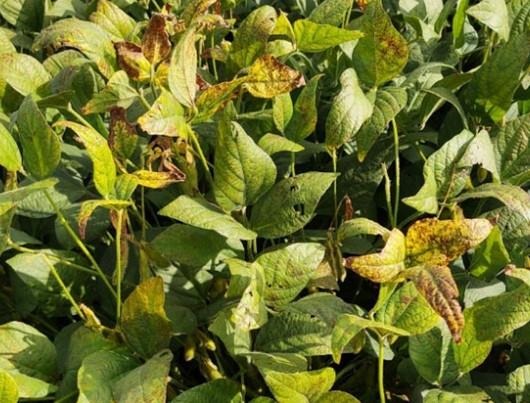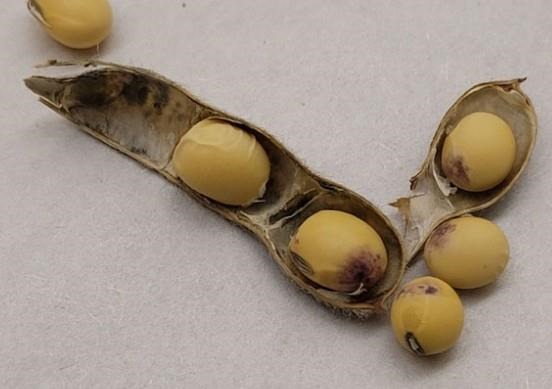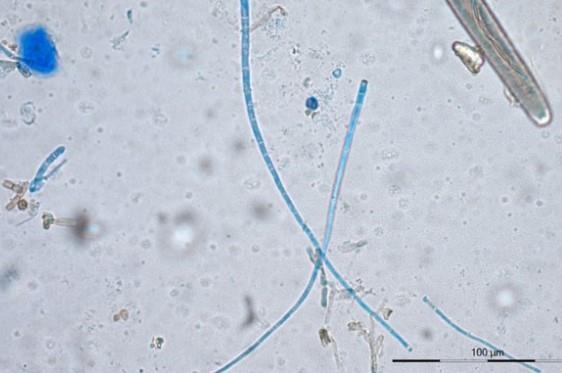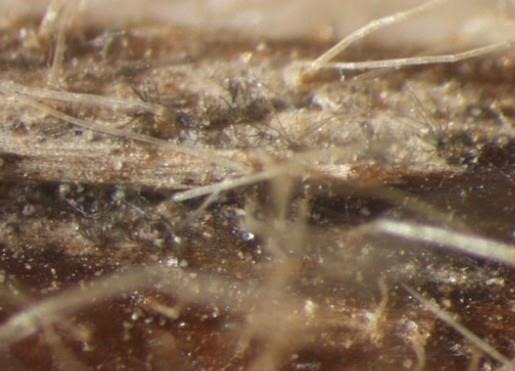In 2021, the MU Plant Diagnostic Clinic received seven soybean samples diagnosed with Cercospora Leaf Blight (CLB). These disease samples were collected from the counties including Vernon, Cooper, Montgomery, Chickasaw, Clark, and Johnson, and most of them were submitted to the MU Plant Diagnostic Clinic toward the end of the growing season. Symptoms of this disease present as severe leaf dropping and premature death. In addition to CLB, we also found other diseases such as charcoal rot, potassium deficiency and anthracnose present on several soybean samples.

Figure 1 Cercospora Leaf Blight disease in the field. Photo: Pat Miller
The causal agent of this disease is a fungus called Cercospora kikuchii. The symptom of this disease begins as purple, brownish spots on leaves. As it progresses, these leaf spots deepen in color and combine to form large necrotic areas that eventually lead to premature defoliation (Figure 1). In addition to significant yield loss resulted from defoliation, this disease can also cause purple seed stain which severely affects the product quality (Figure 2). Cercospora kikuchii produces septate conidiophores with size of 200-300 µm long and 4-5 µm wide while the size of conidia is 170 to 190 µm long and 3 µm wide.

Figure 2 Purple seed stain caused by Cercospora kikuchii. Photo: Peng Tian

Figure 3 Conidia of Cercospora kikuchii (400X). Photo: Peng Tian

Figure 4 Conidiophores and conidia of Cercospora kikuchii under dissecting microscope. Photo: Peng Tian
This disease can survive in plant debris left over from the previous season and unclean seeds. When the weather becomes humid and warm in the spring, the fungus begins to produce spores (conidia) that can be spread to the newly planted soybeans with the help of wind or rain splash, and infect whatever tissue they land on (Figure 3). Once the blight symptoms developed on the leaves, more conidia on the necrotic areas are produced and infect other leaves, stem and seed pod (Figure 4). CLB can also be transmitted by planting a seed infected with the pathogen. Previous studies show that while the symptoms appear on the coat, mycelium of C. kikuchii can penetrate the cotyledonary and embryonic tissues. Based on the communications with the clients this year, this disease progressed very fast and normally caused severe defoliation within two to three weeks.
Disease Management:
- Crop rotation. Reduce number of pathogens present in plant debris by rotating field with other crops.
- Plant disease free seeds.
- Early planting. This cultural method avoids the hot, dry weather of late summer that can exacerbate disease symptoms.
- Choose later-maturing cultivars. Soybeans vary in their response to Cercospora spp., and later-maturing cultivars are typically more resistant to the disease than early-maturing cultivars.
- Chemical control. A foliar fungicide application may be applied in the early pod development stage (R2-R4). However, this has only shown limited results. Seed treatments may also be used if seed lots have higher percentages of infected seeds.
Source : missouri.edu